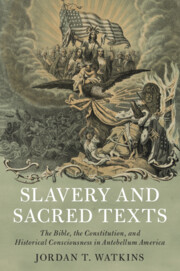 Slavery and Sacred Texts
Slavery and Sacred Texts Published online by Cambridge University Press: 12 June 2021
This chapter shows how Frederick Douglass, Abraham Lincoln, and Theodore Parker used historical distance in their responses to Dred Scott. Parker tied the idea of the Constitution as the act of the ratifiers to the right of the people as interpreters. He believed that the founding generation’s expectation of abolition warranted a progressive popular reading. Lincoln insisted that the framers had used caution to word the Constitution in such a way that slavery would disappear from the American past once their descendants abolished the institution. That the Slave Power had obscured that expectation made it even more important to work towards its realization. Douglass also placed emphasis on the framers’ emancipationist expectations. He distinguished original antislavery meaning from obscuring post-founding-era construction and trusted that Americans would notice the distinction and then use the Constitution to usher in a new era of freedom. The slavery debates forced interpreters to confront historical distance, and Parker, Lincoln, and Douglass used it to insist on radically new readings of the Constitution. Historical distance had become an interpretive force in antebellum America.
To save this book to your Kindle, first ensure [email protected] is added to your Approved Personal Document E-mail List under your Personal Document Settings on the Manage Your Content and Devices page of your Amazon account. Then enter the ‘name’ part of your Kindle email address below. Find out more about saving to your Kindle.
Note you can select to save to either the @free.kindle.com or @kindle.com variations. ‘@free.kindle.com’ emails are free but can only be saved to your device when it is connected to wi-fi. ‘@kindle.com’ emails can be delivered even when you are not connected to wi-fi, but note that service fees apply.
Find out more about the Kindle Personal Document Service.
To save content items to your account, please confirm that you agree to abide by our usage policies. If this is the first time you use this feature, you will be asked to authorise Cambridge Core to connect with your account. Find out more about saving content to Dropbox.
To save content items to your account, please confirm that you agree to abide by our usage policies. If this is the first time you use this feature, you will be asked to authorise Cambridge Core to connect with your account. Find out more about saving content to Google Drive.